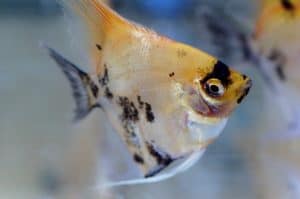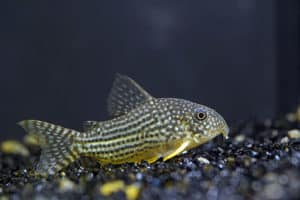I wanted to put together enough information about the common freshwater Angelfish so a beginner could make the decision after reading the info on this page that they would know if having Angelfish as a pet would be right for them. This beginners care guide should help you understand the fish better and get you to understand what it might take to take care and expect for the fish.
Are Freshwater Angelfish Suitable for Beginners?
I have heard and read many people from both sides of the spectrum who think caring for Angelfish is hard as well as caring for the fish is easy. So how can that be? I feel that the people who think Angelfish are hard to take care of did not really do their research to ensure the fish had the correct size of aquarium, the correct water parameters and the right tank mates for Angelfish.
In my opinion freshwater Angelfish are no harder to take care of than a Siamese fighting fish which by the way I hear people saying all the time are hard to take care of. Again it’s because these people don’t care to know what the fish needs to thrive and survive.
Yes freshwater angelfish are suitable for beginners, as long as you provide the environment and food the fish requires.

What are Angelfish and Where do They Come From?
Freshwater angelfish are a type of cichlid fish. Also known as Pterophyllum Scalare this species of cichlid are not as aggressive as other types of cichlids. I don’t find angelfish aggressive at all when in the right habitat.
There are many different types of angelfish. I just hope I have captured all of them. Some of these names you might recognize like the Veil, Marble, Altum and Black Lace. Most of these you can find in local fish stores depending on what part of the world you are in. North and South America will have access to a large variety of these species that come from the wild as well as species that are bred in captivity.
- A list of types of freshwater angelfish are the Veil, Marble, Black Lace, Gold, Albino, Black, Ghost, Blushing, Smokey, Chocolate, Zebra, Clown, Leopard, Koi, Pearl Scale, Half Black, and Altum.
Origin of the Freshwater Angelfish
- Any of the Pterophyllum species of angelfish originate from tropical South America mainly in the Amazon basin as well as the Orinoco basin and many other rivers in the region.
What is the freshwater angelfish’s natural habitat like?
- The angelfish lives in swamps and rivers that are densely vegetated.
- Freshwater angelfish have vertical striping on their bodies which helps them to stay camouflaged to protect them from predators like larger fish and birds as well as to help the fish prey on smaller fish and invertebrates. They will also feed on other bits of food found in the rivers.

How Big Do Freshwater Angelfish Get?
- A full grown angelfish with the right conditions and size of aquarium can reach as big as 8” to 10” tall and 6’ long.
- When these fish are fully grown their beauty shines as they swim about the aquarium.
Aquarium set up
- Plantsare a must in an angelfish’s aquarium. Angelfish swim and hide among the vegetation in their natural habitat so will need to do the same in your aquarium.
- Substrate can be aquarium gravel or sand whatever you prefer.
- That being said, because of the shape and how large these fish get do not over crowd your tank with plants. Make sure there is enough room for the fish to swim freely.
- The ideal temperaturein an angelfish tank is approximately 75 Fahrenheit to 80 Fahrenheit. In Celsius you want the temp to be in the range of 23.9 to 27.8.
- Considering water flow is very important. Angelfish do not swim well in very strong currents. Obviously you must have your filtration system running to keep your water properly filtered so you have a couple options. You can baffle the input of the water into the tank so the incoming current is not as strong or you can make sure any input of the water flow should be muffled by the plants in the tank. I like either option.
- Aquarium lighting for angelfish should be somewhat filtered and the best way to do this is to have live plants that float on the water or plants that grow the height of the tank quickly to help subdue the light.
What is the Best Food for Angelfish?
Now that you have your tank set up properly it wouldn’t make sense to provide anything other than the most nutritious foods for your angelfish. The great thing about fish food suppliers these days is they know what fish need to eat what food and make sure there are pictures of the fish and or a list of fish that should be eating the food they are packaging.
So honestly if you see a picture of an angelfish or any other type of Cichlid on the package then that is a food that you should purchase. That being said of course it is possible the company does not list “angelfish” or have a picture on the package. Things you must know when selecting food.
- Angelfish are omnivores which means they enjoy eating meat and plants. The fact that they are omnivores means the next bullet point is very important to follow.
- Variety is the best way to ensure a healthy fish. Don’t just buy a bottle of flake food and only feed your fish the flake food. You risk the fish getting sick or developing some sort of deficiency. The best thing to do is rotate different food sources for your angelfish and any other type of fish.
- Freshwater angelfish food should consist of frozen brine shrimp, frozen bloodworms, frozen mysis shrimp and even plankton. These frozen foods will satisfy the meat needs of your fish.
- Other foods to have on hand can be pellets and flake foods. The wonderful thing about flake and pellet foods is they will last a very long time without going bad. You can select cichlid pellets and flakes as well as other types that include angelfish as a fish that can eat that particular food.
- Freeze dried foods are also an option. You can purchase freeze dried bloodworms, brine shrimp and Mysis shrimp as well as other types of freeze dried foods.
- Bonus option for you is to consider cooked peas removing the shell of the pea then breaking up the insides a bit. Lettuce, cucumbers and zucchini’s are all great options.
The general rule when feeding aquarium fish is to only feed the fish as much as they can eat in a couple of minutes. I would also say that once you find a food your fish prefer it is okay to feed the fish that food 50% or more of the time and supplement with the other varieties.
You should feed your angels twice a day as well.

What are Good Freshwater Angelfish Tank Mates?
This is a fun part in starting an aquarium and buying fish. For most people this is an afterthought as to what fish they will purchase. Sure they know they want an angelfish or another type of fish yet they never considered what fish can leave peacefully with the other. It is a very important piece of the puzzle. If you have fish that are aggressive to others then some fish might die because of making an incorrect choice in tank mates. Some things to consider when choosing suitable tank mates.
How to Tell the Sex of an Angelfish
- It is much easier to tell the sex of an adult angelfish that it is of a juvenile.
- When angelfish are mature you can locate a small tube like feature on their belly just past the long feeler fins that drop down.
- A male angelfish will have a tube that looks somewhat cylindrical where a female will have a more tapered tube.
- If you can’t wait until they are adults to figure out their gender you can check the shape of their crown (the front/top of their heads).
- A males crown shoots up more predominately than a females.
- A females crown is much more rounded.
- Another way to tell gender is to check body size. Females of the same age tend to be a bit smaller.
- Another way is to identify when your angelfish pair up for long periods of time. Then you know that one must be a male and one a female. Unless of course they are two females.
- So obviously it is not super easy to identify the gender of angelfish however with a bit of patience and observation you should eventually get the hang of how to identify these beautiful fishes gender.
Freshwater Angelfish Personality
- Angelfish are semi-aggressive meaning they might nip at some fish they don’t like. For instance Neon Tetra’s are in danger around angelfish.
Are freshwater Angelfish Schooling Fish?
- Yes angelfish are schooling fish. There is one consideration here though that you have to take into account when stocking your aquarium. Here are the rules of stocking these fish in you aquarium. It’s as simple as this. You can have any number of angelfish in your tank (assuming the tank is the appropriate size) other than 3 fish.If you have 3 then two might pair up and attack the third one. that is about the only rule to worry about.
Where do Angelfish Swim in The Tank?
- When in an angelfish community tank you will find your angelfish swimming primarily in the middle of the tank.
- When you start adding other types of fish you will find that your angelfish might start occupying the middle and the top of the aquarium water.
- It is very unlikely that you will find your angelfish living at the bottom portion of the tank water. They will however venture to the bottom to pick up food.

So What Kind of Fish Can You Put with Angelfish?
No matter how big your aquarium is you need to pay attention to what fish you put in the same tank together. There are some great options to stock your tank with.
- Corydoras Catfish
o Corydoras catfish are very friendly and can be kept in schools. They also occupy mostly the  bottom of the tank so are a great choice for a tank mate that mostly occupies the middle and or the top of the tank.
bottom of the tank so are a great choice for a tank mate that mostly occupies the middle and or the top of the tank.
- Rams
o Ram Cichlids come from the same region as angelfish and would make a great tankmate for them. They will also add some extra color to the tank.
- Cherry Barbs
o Cherry barbs are a slender fish displaying a beautiful blend of red and orange coloring. The Cherry Barb likes to be in a well planted aquarium so will do well living amongst and angelfish community.
- Plecostomus
o Plecostomus fish enjoy well planted tanks and you can have multiple of these fish in the same  tank. Make sure to have some river wood in your tank for this fish to feed on.
tank. Make sure to have some river wood in your tank for this fish to feed on.
- Platies
o Assorted Platy’s are a peaceful omnivore. Platy’s must be in a well planted tank which again fits in nicely with your angelfish.
- Mollies
o Mollie’s are another omnivore with a peaceful temperament. They also enjoy a lot of live plants.
- Silver Dollars
o Silver Dollars look like they might be vicious predators yet they are not. Silver Dollars are peaceful Herbivore’s. They do get quite large similar to an angelfish. Silver Dollars can grow as large as 6”.
The only issue mixing Silver Dollars and Angelfish is that the Silver Dollars might eat the live plants. If you mix in some fake plants then you should be okay. Also make sure to keep them well fed so they don’t start picking on the plants.
- Denison barbs
- Denison Barbs grow 4” or more and are long sleek fish.
- Denison’s are peaceful omnivores that are best kept in small schools. Denison’s like to jump out of water so make sure you have an aquarium lid if you purchase these fish.
- Denison’s should be kept in larger tanks starting around 50 or 55 gallon. Denison Barbs are recognized by the black line running down the center of the length of their bodies.
There are definitely more choices for tank mates to the angelfish however I feel this list should give you a great start in filling an aquarium.
How Big of a Tank Do You Need for Freshwater Angelfish?
The answer to this will be a matter of opinion and experience from whomever you ask. For just 1 angelfish you could have it in a 30 gallon aquarium. Chances are though that you will want to have more than 1 fish in an aquarium whether it is another angelfish or another species.
My recommendation for a freshwater angelfish tank size is to not have anything smaller than a 30 gallon for 1 fish. If you get a pair or more (make sure you never have 3 in a tank) then jump up to a 55 gallon (over 200 liters) or larger right away. If you want to read a great review I did of an awesome aquarium then check out this Seaclear Review or if you want to go right to Amazon to check out this beautiful aquarium then check it out here at Seaclear Aquarium.
Freshwater Angelfish Life Span
- How long can an angelfish live in an aquarium you ask?
- They could live up to 10 years if kept in suitable conditions in a large enough tank with the proper nutrition and tank mates. Unfortunately as hard as we try fish kept in an aquarium usually don’t live as long as in their natural habitat.
- Do your best to give your angelfish a good home and you can expect them to live 5 years and maybe more.

Recommended Posts
5 Reasons Your Angelfish Is Not Eating (and What to Do)




